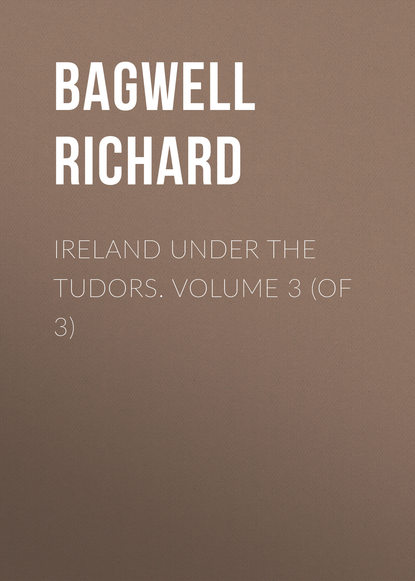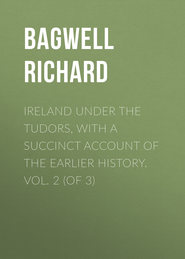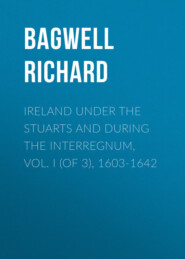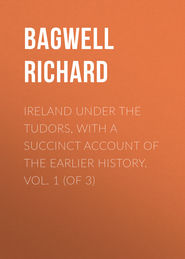По всем вопросам обращайтесь на: info@litportal.ru
(©) 2003-2024.
✖
Ireland under the Tudors. Volume 3 (of 3)
Настройки чтения
Размер шрифта
Высота строк
Поля
263
Russell’s Journal; Declaration by the Lord Deputy and Council (including Norris and Fenton) in Carew, No. 261, soon after Christmas 1596.
264
Calendar of S. P. Domestic, Sept. 30 and Dec. 22, 1596; Letters in Carew from Nov. 30 to Dec. 9. On Aug. 10 Tyrone wrote to Russell that he was surprised at his reasonable offer of peace not being accepted; this was a month after his incendiary letter to the Munster chiefs. Russell answered that peace with his sovereign was a ‘proud word,’ and that he was sent to ‘cherish the dutiful and correct the lewd, of which number thou art the ringleader… thy popish shavelings shall not absolve thee’ (MSS. Lansdowne, vol. lxxxiv). Petition of Sir W. Russell in Carew, 1596, No. 253. As to the letters see Burghley to his son Robert, March 30, 1596, in Wright’s Elizabeth and elsewhere. On Oct. 22, 1596, Anthony Bacon wrote to his mother ‘that from Ireland there were cross advertisements from the Lord Deputy on the one side, and Sir John Norris on the other, the first as a good trumpet, sounding continually the alarm against the enemy, the latter serving as a treble viol to invite to dance and be merry upon false hopes of a hollow peace, and that these opposite accounts made many fear rather the ruin than the reformation of the State, upon that infallible ground, quod omne regnum divisum in se dissipabitur’; which sums up the situation very well. – Birch’s Memoirs, ii. 180.
265
These abortive negotiations are pretty fully detailed in Fynes Moryson’s Itinerary, part ii. book i. ch. i. under 1596; Russell’s Journal.
266
Clanricarde to Russell, Jan. 15, 1597; Oliver French, mayor of Galway, to Russell, Jan. 19; Bingham to Sir R. Gardiner, Jan. 20 and 27. These four letters are printed in Wright’s Elizabeth. Russell’s Journal; Four Masters, 1596 and 1597; the Queen to the Lord Deputy and Council, Dec. 4, 1596, in Morrin’s Patent Rolls, under 39 Eliz.: ‘As to the proceeding for the examination of the complaint against Bingham and the trial thereof, we think it meet that, after the complaints shall be made privy of our hard usage of him here, and the remitting of him to be tried in Connaught, &c.’
267
Sir T. Wilkes to Sir Robert Sidney, Jan. 17, 1597; Rowland Whyte to same, Feb. 21, March 4, April 13, in Sidney Papers, vol. ii.; Motley’s United Netherlands, ch. ix. The explosion of powder was on March 13, and is recorded by the Four Masters and in Russell’s Journal.
268
Rowland Whyte to Sir R. Sidney in Sidney Papers, May 4, 1597; Lord Burgh to Cecil, April 26 and May 4, MSS. Hatfield, and to Burghley, May 23. R. O. Burgh left London May 3, and reached Dublin on the 15th. He suffered from a wound or hurt received in Holland in 1595, see his letter to Essex of Aug. 27, and that year in Birch’s Memoirs, i. 285.
269
Russell’s Journal in Carew, May 1597; Chamberlain’s Letters, June 11; Burgh to Cecil, May 24 and June 12; Norris to Cecil, May 24 and June 10; Russell to the Privy Council, June 25, MS. Hatfield.
270
Captain Richard Turner (sergeant-major) to Essex, June 14; Lord Burgh to Cecil, received July 28. Several other letters are printed in the Hist. MSS., Ireland, part iv. 1, appx. 12.
271
Essex to the Queen (July) in Calendar of S. P. Domestic; Cecil to Burgh (end of July); Tyrone to the King of Spain (not before August) 1597, in Carew, No. 275.
272
Four Masters, 1597; Clifford to Burgh, Aug. 9. This Lord Inchiquin (Murrogh, 4th Baron) served in Perrott’s Parliament.
273
Four Masters, 1597; O’Sullivan Bere; Clifford to Burgh, Aug. 9; Sir Calisthenes Brooke to Cecil, Aug. 13. As was more fully proved in 1689, the possessors of Enniskillen and of the Erne from Belleek to Ballyshannon, about four miles, held the keys of the partition between Ulster and Connaught.
274
Tyrone to Burgh, Aug. 10, 1597, and the answer, Aug. 16.
275
Lord Burgh’s will, Oct. 12, 1597; Sir H. Bagenal to the Queen, to Burghley, and to Cecil, Oct. 13; Rowland Whyte to Sir R. Sidney, Feb. 1, 1598, in Sidney Papers; Frances Lady Burgh to Cecil, Jan. 1599 (one of several), Hatfield. For the assault and relief of the fort see Fenton to Cecil, Oct. 5, 1597; Captain Williams to the Privy Council, Nov. 1; the Four Masters; Moryson. Burgh died Oct. 13, a wrong date being usually given; he had no recent wound apparently.
276
Sir John Norris to the Privy Council and to Cecil, June 10, 1597; to Burghley, June 2; to Cecil, July 20; O’Sullivan Bere, tom. iii. lib. iii. cap. 10. The Queen’s letter of Sept. 22 to Lady Norris, which begins ‘My own crow,’ has been printed by Fuller, Lloyd, and others. Norris died before Sept. 9, on which day the Presidency of Munster was placed in commission. In an undated letter at Hatfield, which evidently belongs to the early part of 1597, Norris begs leave for ‘this spring’ before it is too late. His lungs were affected, besides the trouble from his wounded leg.
277
Services of Sir John Chichester and the garrison of Carrickfergus, Sept. 16, 1597.
278
Egerton, North, Charles Maunsell, and Merriman to Lord Justice Norris, Nov. 6, 1597, enclosing Lieutenant Harte’s account, who was present. Other accounts are collected in the Ulster Journal of Archæology, vol. v. pp. 188 sqq. See also Gregory’s Western Highlands, chap. vi., where James MacSorley is called ‘Dunluce,’ as if that had been a Scotch lairdship. Chichester’s overthrow was on Nov. 4.
279
Sir T. Norris to Cecil, Oct. 31, 1597. For the terms on which Ormonde and the Lords Justices were appointed see Liber Munerum Publicorum, part ii. p. 5. The Queen to Ormonde, Dec. 29, in Carew.
280
Submission to Ormonde, Dec. 22, 1597; the Queen to Ormonde, Dec. 29; Heads of agreement submitted at Dundalk, March 15, 1598, all in Carew; Fenton to Cecil, April 20. The course of the negotiations may be traced clearly in Moryson, under the year 1597-8. The abortive pardon was dated April 11.
281
Florence MacCarthy’s Life, chap. viii. Honora Lady Clancare and Florence MacCarthy to Cecil, July 29 and Aug. 8, 1598, MSS. Hatfield.
282
Letter of advice to the Earl of Essex, to take upon him the care of Irish causes, when Mr. Secretary Cecil was in France (February to April, 1598), and a second letter from Bacon a little later, both printed by Spedding, vol. ii. pp. 94-1_0. There are many significant passages in Rowland Whyte’s letters in Sidney Papers, vol. ii. pp. 82-97. Essex was busy with Ireland before Cecil’s departure and before Bacon’s first letter, for Whyte wrote on Jan. 19: ‘Yesterday in the afternoon I went to the Court to attend my Lord of Essex, and he no sooner began to hearken unto me, but in comes my Lord of Thomond, in post from Ireland, and then was I commanded to take some other time.’ And see Chamberlain’s Letters, May 4, 1598. Spenser, who wrote in 1596 proposes that Essex should be Lord-Lieutenant, ‘upon whom the eye of all England is fixed, and our last hopes now rest.’
283
Fenton to Cecil, June 11; Ormonde to Cecil, June 18. O’Sullivan Bere (tom. iii. lib. iv. cap. iii.) owns to 120 killed in the attempted escalade. The eating of grass by the garrison recalls the defence of Casilinum against Hannibal (Livy, xxiii. 19).
284
Loftus, Gardiner, Wallop, St. Leger, and Fenton to the Privy Council, Aug. 16; Lords Justices Loftus and Gardiner to the Privy Council (‘in private’), Aug. 17; Ormonde to the Queen, Aug. 18; State of the Queen’s army, March 31, 1598, printed in the National MSS. of Ireland from a paper at Kilkenny.
285
Lieut. William Taaffe to H. Shee, Aug. 16. He calls the powder-barrels ‘firkins.’ Captain Montague’s Report, Aug. 16; Declaration of the two Captains Kingsmill, Aug. 23, and that of Captain Billings who commanded the rearguard. All the above, with many other papers, are printed either in Irish Arch. Journal, N.S. vol. i. pp. 256-282, or in National MSS. of Ireland, part iv. 1. See also Camden and the Four Masters. There is a minute and nearly contemporary account in O’Sullivan Bere, tom. iii. lib. iv. cap. 5, but he was not present. It is O’Sullivan who mentions the junipers, which do not now grow wild about Armagh. I have carefully inspected the ground, having besides the advantage of consulting two pamphlets kindly sent to me by Mr. E. Rogers of the Armagh Library, whose great local knowledge has been brought to bear on the subject.
286
O’Sullivan; Montague to Ormonde, Aug. 16. The English accounts specify twelve colours as lost; O’Sullivan says thirty-four.
287
Ormonde to Cecil, Sept. 15. In writing to the same, on Aug. 24, Ormonde admits the reduced list of twenty-four officers killed and one taken prisoner, 855 men killed and 363 wounded. To these must be added the missing, and there were certainly several hundred deserters. Other English estimates of loss are considerably higher. Camden says 1,500 men were killed.








